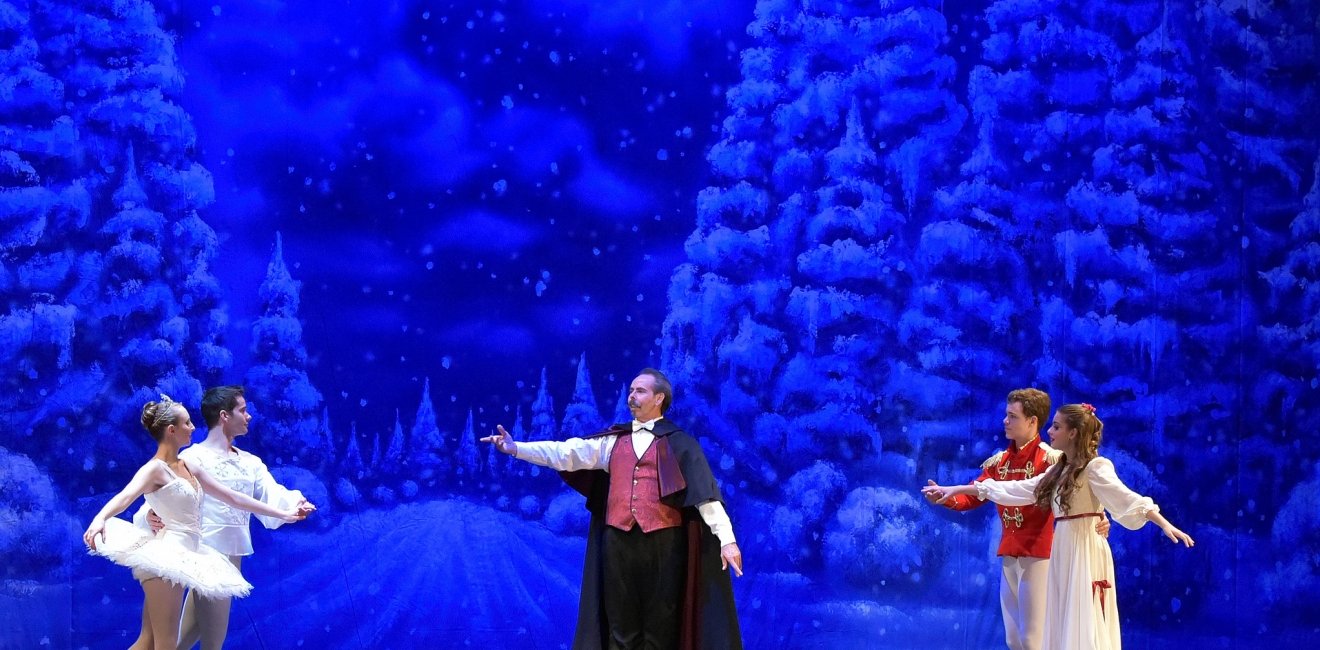
A blog of the Kennan Institute
BY NATALIE ROULAND
Far from its Russian imperial home, The Nutcracker has flourished not only as an American holiday tradition but also as the financial backbone of most American ballet companies.
The ballet, which premiered in St. Petersburg on December 6, 1892, at the behest of Czar Alexander III, was based on Alexandre Dumas’s adaptation (1844) of E. T. A. Hoffmann’s “The Nutcracker and the Mouse King” (1816). The ballet capitalized on the recent success of The Sleeping Beauty (1890) and featured the music of Piotr Tchaikovsky and the choreography of Marius Petipa and Lev Ivanov.
While the original ballet was not deemed a cohesive production, the Petersburg Gazette declared the score the best of Tchaikovsky’s ballets. And the myriad iterations over the course of the twentieth century made The Nutcracker one of the most famous ballets in the classical canon.
Indeed, The Nutcracker today continues to provide essential ticket-sale revenue and performance experience for ballet companies and schools across America. Which begs the question: Without Russia, would there be an American ballet?
The simple answer is no. During the colonial and early republican eras, European dancers and ballet masters provided instruction and inspiration to a nascent American citizenry. President George Washington himself, along with ballet master Pierre Landrin Duport, whose dance compositions are housed at the Library of Congress, cultivated social and theatrical dance as part of the civilizing process of the young republic. In 1840 the American tour of the ballerina Fanny Elssler caused a riot in New York and shut down Congress in Washington. Yet by the beginning of the twentieth century, no professional school of American ballet existed.
The cultural phenomenon of Sergei Diaghilev’s Ballets Russes and its splinter groups, including the Ballet Russe de Monte Carlo and the personal companies of Diaghilev artists Michel Fokine, Adolph Bolm, and Anna Pavlova (to name a few), inundated America with a style of ballet that finally stuck.
The musically sophisticated, visually arresting, and often provocative dance offerings, stripped of the imperial pomp that had once served as evening-long entertainment in St. Petersburg, captivated American audiences from coast to coast. From these traveling tours, the iconoclastic choreographer George Balanchine and the fabled dancer Alexandra Danilova emerged as key figures of American ballet.
Balanchine went on to found the School of American Ballet in 1934 and the New York City Ballet in 1948, which remain hallmarks of the American ballet style. Danilova coached generations of dancers from national and local companies, including the American Ballet Theatre, the San Francisco Ballet, the Cincinnati Ballet, and the Washington Ballet, in the rigorous technique and magisterial repertoire of the Russian imperial theater system.
The classical canon of Russian ballet proliferated on makeshift American stages in abridged versions and often under the auspices of the more established opera. Yet many American companies were semiprofessional until the influx of cultural capital following World War II.
The Nutcracker proved pivotal in securing the place of ballet in the hearts—and pockets—of the American public. Pavlova provided America’s first glimpse of The Nutcracker in her 1911 ballet Snowflakes, based on the eponymous Waltz of the Snowflakes. The Ballet Russe de Monte Carlo debuted an abbreviated production of The Nutcracker in New York in 1940. And the San Francisco Ballet’s Willam Christensen choreographed the first full-length American production in 1944 with the aid of a Tchaikovsky score from the Library of Congress and the childhood memories of Danilova and Balanchine.
While students at the Imperial Theatre School, Danilova and Balanchine performed a wide range of roles in The Nutcracker. Danilova’s performance of the ballet’s young heroine, Clara, informed her insistence in mid-century American productions that the part be danced on toe, or sur les pointes. And while Balanchine interpreted roles from the Nutcracker Prince to the Mouse King, his rendering of the solo in the trepak-themed Candy Cane variation “always brought down the house,” according to Danilova, “with his sensational jumps through a hoop.”
Following her 1924 emigration from Leningrad with Balanchine and his first wife, Tamara Geva, Danilova showcased the glamour of the Sugar Plum Fairy as the international star of the Ballet Russe de Monte Carlo. Balanchine’s later 1954 Nutcracker for the New York City Ballet amplified the magical quality of the Sugar Plum Fairy by reviving a stage trick of Ivanov’s (recorded in the Stepanov choreographic notation by Nikolai Sergeev) in which the ballerina appeared to glide across the stage by means of a reika, or guided track. Both the colossal Christmas tree (which grows to a height of forty-one feet) and the whimsical snowflake costumes by Karinska evoked the wonder of his childhood in imperial Russia.
Danilova herself staged two productions of The Nutcracker in Washington alone: the first in 1961 for the Washington Ballet under the direction of Mary Day, and the second in 1964 with Ballet Russe de Monte Carlo costar Frederic Franklin for the National Ballet, itself a break-away group of the Washington Ballet.
In 1976 the dancer-defector and Cold War celebrity Mikhail Baryshnikov premiered a new Nutcracker with the American Ballet Theatre at the Kennedy Center. The 1977 film, in which he co-starred with Gelsey Kirkland, both preserved and popularized Baryshnikov’s vision and anticipated the at-home Nutcracker screenings currently dictated by the COVID-19 crisis in the performing arts.
While the New York City Ballet will not offer its astounding run of forty-seven performances of The Nutcracker this year, the Miami City Ballet will perform George Balanchine's The Nutcracker® in the Park to audiences assembled outside in socially distanced pods. Rapidly adapting companies such as the New York City Ballet, the San Francisco Ballet, the Boston Ballet, and the Washington Ballet will present digital Nutcracker experiences to diminish the massive losses incurred by the pandemic.
One cannot help but recall the original Nutcracker, born from the personal tragedy and professional disappointment of Tchaikovsky, who felt himself at odds with the imperial theater directorate even as he mourned the death of this beloved sister Alexandra. Similarly, Petipa shrank from work on The Nutcracker because of an illness precipitated in part by the death of his daughter, Evgenia. Viewed in historical context, the ballet becomes a meditation on the fragile and fleeting space of childhood.
In the Mariinsky Theatre production of 1892, Clara does not awaken at the end of the ballet to discover it was all a dream: Clara remains in the enchanted land of Confiturembürg. The division between the mundane reality of the family home in Act I and the fantastic realm of the sweets in Act II collapses. The child Clara marries her Nutcracker Prince, is crowned Queen of Confiturembürg, and rather grandly escapes the cruelty of her brother Fritz, the tyranny of the seven-headed Mouse King, the machinations of her godfather Drosselmeyer, and the shadow of illness implied in the libretto’s literary subtext. What W. H. Auden has termed the “present Eden” of The Nutcracker triumphs over the threats of war, pestilence, violence, indifference.
The art of Russian ballet has left a lasting legacy on the American landscape, and through the ritualistic tradition of The Nutcracker, its past becomes present every holiday season.
The opinions expressed in this article are those solely of the author and do not reflect the views of the Kennan Institute.
Author

Scholar In Residence, The Washington Ballet

Kennan Institute
After more than 50 years as a vital part of the Wilson Center legacy, the Kennan Institute has become an independent think tank. You can find the current website for the Kennan Institute at kennaninstitute.org. Please look for future announcements about partnership activities between the Wilson Center and the Kennan Institute at Wilson Center Press Room. The Kennan Institute is the premier US center for advanced research on Eurasia and the oldest and largest regional program at the Woodrow Wilson International Center for Scholars. The Kennan Institute is committed to improving American understanding of Russia, Ukraine, Central Asia, the South Caucasus, and the surrounding region through research and exchange. Read more

Explore More in The Russia File
Browse The Russia File
Chechnya as a Model of Modern Russia

Russia’s Indigenous Communities and the War in Ukraine

Gas and Power in a Changing US–Russia Relationship

